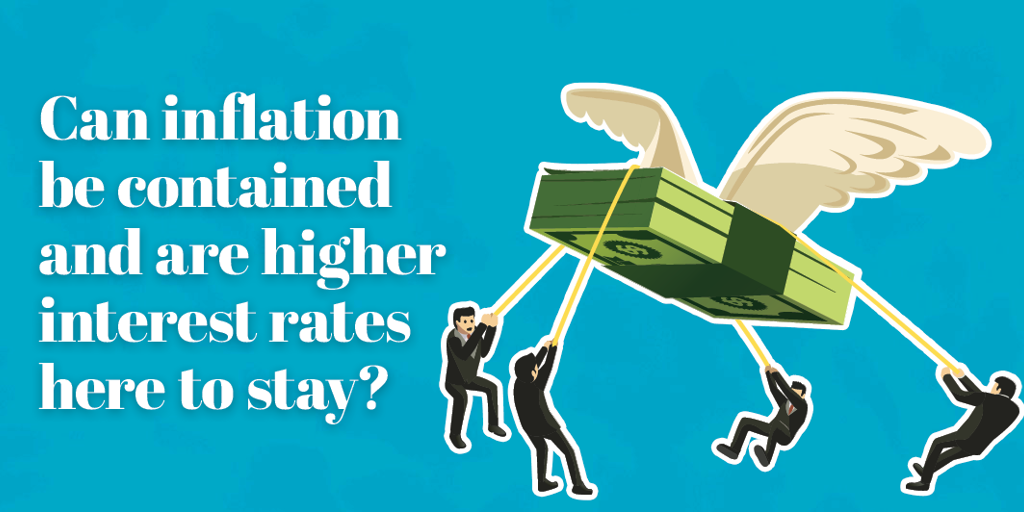


Can inflation be contained and are higher interest rates here to stay?
It has become clear that inflation is not as “transitory” as the Federal Reserve originally believed. In reaction to persistent inflation, the Fed has embarked on the most aggressive monetary tightening policy in modern history. The question many are asking is: Will it work? And, if so, at what cost?
How we got here
To evaluate how we solve the current situation, we need to evaluate how we got here. Basic economics instructs us that prices live at the intersection of the supply and demand curves. Supply is determined by how much of a good is produced, and demand is determined by the desire and capacity of the consumer to buy the good or service. COVID created a historical mismatch in both supply and demand. Quarantines, social restrictions, and personal choices significantly impacted the production and distribution of goods and services. As a result, a very complex but efficient global supply chain was broken, and the supply of virtually all goods and services -- including the most basic of goods like toilet paper and baby formula -- was disrupted.
 We also saw an unprecedented injection of fiscal and monetary stimulus into the global economy. From a recession-avoidance perspective, this stimulus has been effective. In April 2020, the Bureau of Labor statistics (BLS) reported the unemployment rate at 14.8% -- the highest level ever recorded -- and a GDP reading of -31.4% for the second quarter of 2020. By the end of 2021, unemployment was below 4% and GDP had returned to pre-pandemic levels. Much of this recovery can be attributed to aggressive money creation. As a result, the Fed’s balance sheet grew from $4.1 trillion in February 2020 to more than $8.9 trillion by mid-2022. This means more than half of all dollars in existence today were created in the last 2 ½ years. More dollars chasing fewer supply-constrained goods is a recipe for inflation.
We also saw an unprecedented injection of fiscal and monetary stimulus into the global economy. From a recession-avoidance perspective, this stimulus has been effective. In April 2020, the Bureau of Labor statistics (BLS) reported the unemployment rate at 14.8% -- the highest level ever recorded -- and a GDP reading of -31.4% for the second quarter of 2020. By the end of 2021, unemployment was below 4% and GDP had returned to pre-pandemic levels. Much of this recovery can be attributed to aggressive money creation. As a result, the Fed’s balance sheet grew from $4.1 trillion in February 2020 to more than $8.9 trillion by mid-2022. This means more than half of all dollars in existence today were created in the last 2 ½ years. More dollars chasing fewer supply-constrained goods is a recipe for inflation.
With the benefit of hindsight, it is clear the Fed has made several errors in the current economic cycle that are contributing to our current inflation situation:
- In August 2020, at the Jackson Hole symposium, Chairman Jerome Powell announced a policy change in inflation strategy, adopting “average inflation targeting” or a “reactive” approach vs. the traditional “proactive” approach.
- When inflation appeared in early 2021, the Fed stated it was “transitory,” believing the anticipated COVID reopening would improve supply chains sufficiently to eliminate inflationary pressures. COVID proved far more challenging than anticipated, and supply chains have been slow to recover.
- When tightening eventually began, it was too late (March 2022) and too timid (just 0.25%). By late 2021, it was obvious that inflation was accelerating,
How do we combat inflation?
Nobel prize-winning economist and former Fed Chairman Ben Bernanke stated in 2010 that “there is really no problem with raising rates, tightening monetary policy, slowing the economy and reducing inflation … this can be done in 15 minutes.” While the decision to raise rates can be made quickly, the impact on inflation is taking significantly longer.
The Fed has begun raising rates. In fact, the pace and level of interest-rate increases have been the most dramatic in modern history. Despite the dramatic rise in rates, inflation remains elevated. Why?
- Monetary policy takes time. People and corporations do not change behavior instantly. Major purchases and capital projects take months of planning and tend to follow through to completion. But new projects and large expenditures -- such as a home purchase -- will be re-evaluated at higher interest rates. Economists generally agree it takes 6 to 12 months for the full impact of an interest rate hike to show up in economic numbers.
- Higher rates don’t improve supply. Much of the supply/demand mismatch is a result of constrained supply. Higher rates destroy demand; they do not increase output. In fact, higher rates can have the exact opposite effect by making capital more expensive. This is important as “reshoring” efforts will require significant capital investment in the form of new factories and labor.
- The geopolitical landscape has shifted. One of the reasons the Fed’s initial rate hike was only 0.25% was the invasion of Ukraine by Russia only days before the March meeting. The Fed saw this as an economic destabilizing event and chose to be less aggressive with its initial rate hike.
This instability continues as the Fed tries to thread the needle between effective inflation control and global market stability. - The true cause of inflation might be the labor shortage. While there has been a lot of talk about the supply chain’s impact on inflation, imported goods represented only $3.3 trillion of our $25.7 trillion GDP (roughly 12%), according to the Q3 2022 advance report from the Bureau of Economic Analysis. Services accounted for $11.5 trillion (nearly 45%). Services tend to be more labor intensive, harder to offshore, and more difficult to automate.
As the world has emerged from the pandemic, spending has shifted from goods consumption to services consumption. This has only highlighted the ongoing holes in the labor market. According to the BLS, the number of job openings exceeded the number of unemployed workers early last summer. By September 2022, the number of available workers per job opening was 0.5. To put this in perspective, in 2009, after the financial crisis, there were 6.5 available workers per job opening. A tight labor market feeds inflation in two ways -- overall supply is constrained due to underproduction relative to demand, and competition for labor tends to push up labor costs, resulting in higher prices.
What does this mean going forward?
Inflation will likely remain until the open job/available worker ratio returns to equilibrium. Until then, we should probably expect higher prices and higher rates.
Warren Hurt is Chief Investment Officer for F&M Trust.
Recent Articles
Join our e-newsletter
Sign up for our e-newsletter to get new content each month.






















